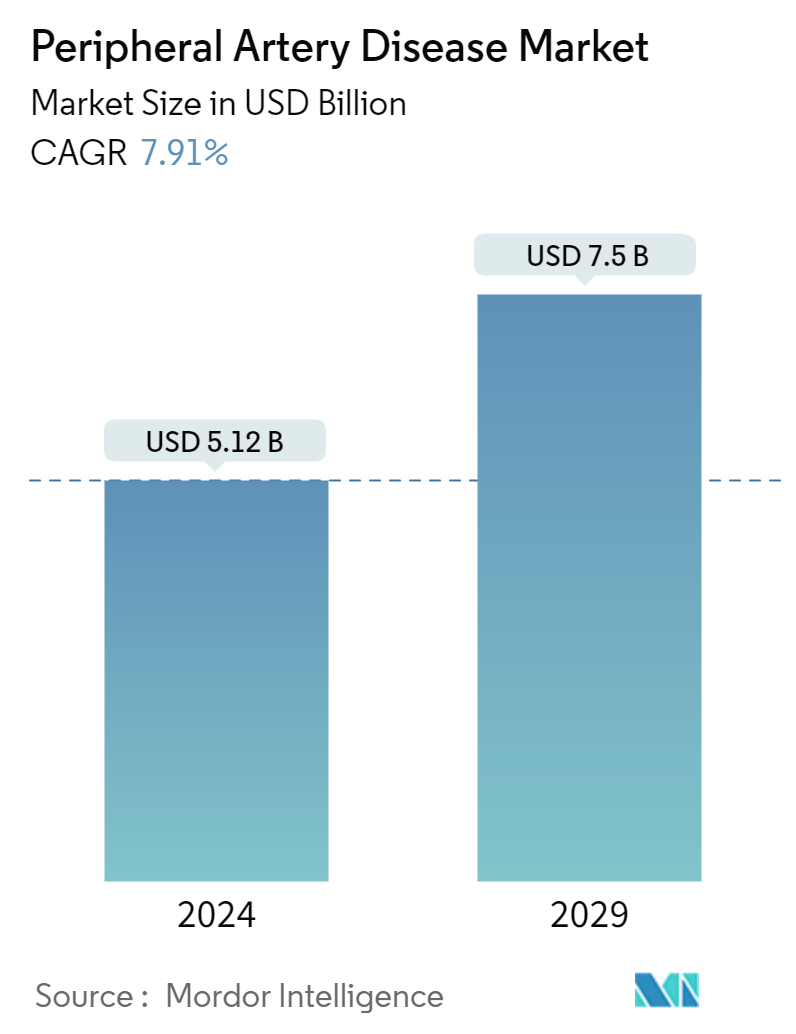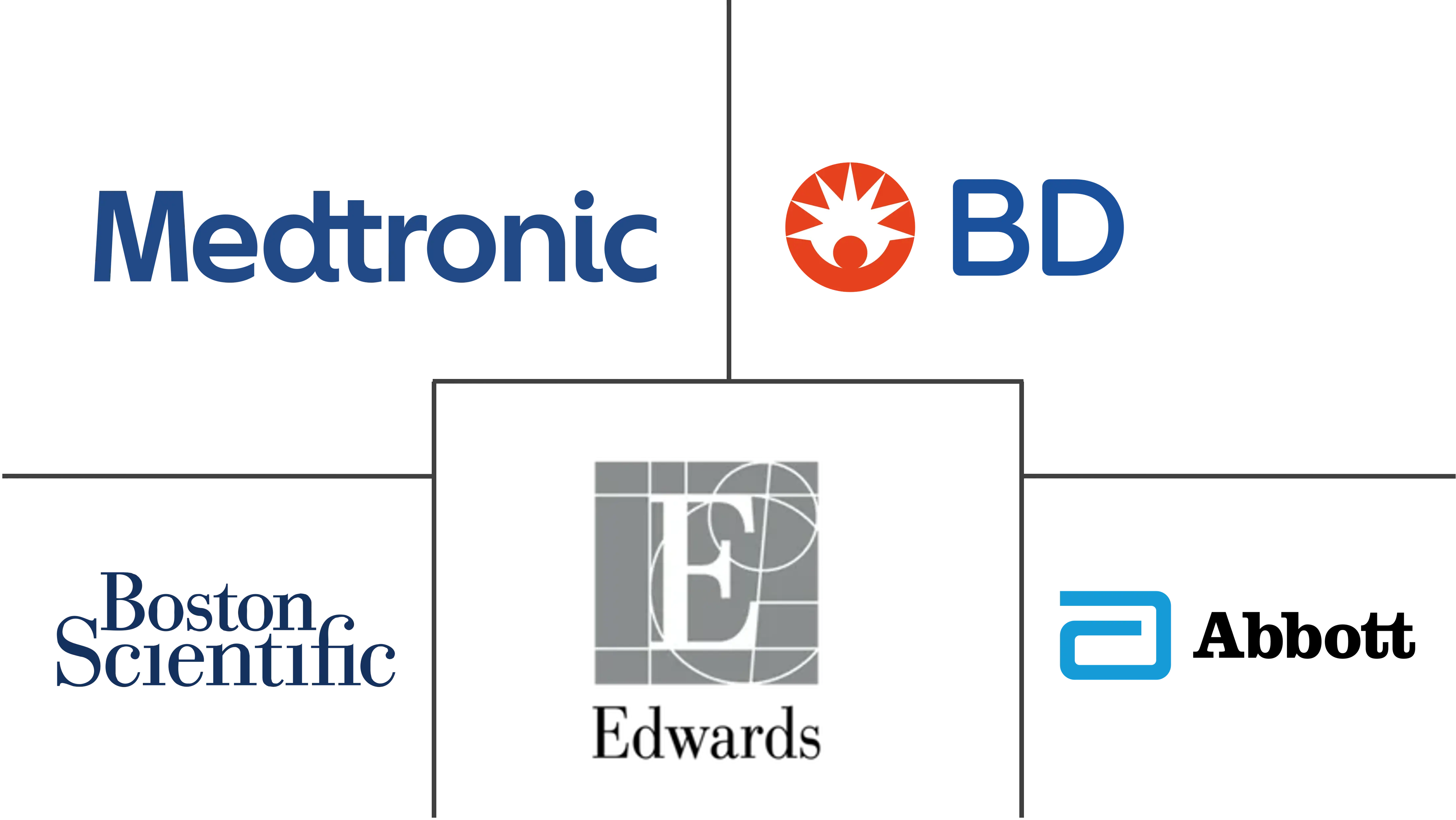Market Size of Peripheral Artery Disease Industry

| Study Period | 2019 - 2029 |
| Market Size (2024) | USD 5.12 Billion |
| Market Size (2029) | USD 7.5 Billion |
| CAGR (2024 - 2029) | 7.91 % |
| Fastest Growing Market | Asia Pacific |
| Largest Market | North America |
| Market Concentration | High |
Major Players
*Disclaimer: Major Players sorted in no particular order |
Peripheral Artery Disease Market Analysis
The Peripheral Artery Disease Market size is estimated at USD 5.12 billion in 2024, and is expected to reach USD 7.5 billion by 2029, growing at a CAGR of 7.91% during the forecast period (2024-2029).
Factors such as the rising burden of peripheral artery disease (PAD), technological advancements in peripheral devices, and increasing prevalence of risk factors such as diabetes and hypertension, coupled with the growing geriatric population, are expected to boost the growth of the peripheral artery disease market over the forecast period. Also, new product launches and regulatory approvals are expected to drive market growth.
The peripheral artery disease (PAD) market is witnessing significant growth, primarily fueled by the rising prevalence of the condition. The rise of unhealthy lifestyle habits like smoking, diabetes, and obesity also contributes to the rising burden of PAD. For instance, the American Heart Association reported in June 2023 that over 200 million individuals globally are affected by PAD, a trend propelled by an aging demographic and detrimental lifestyle habits.
Similarly, according to a study published by StatPearls Publishing LLC in May 2023, peripheral arterial disease (PAD) stands as the third leading cause of atherosclerotic morbidity, following coronary heart disease and stroke. Given the significant burden of PAD, there is an expected surge in demand for both effective medication and advanced treatment devices. This rising demand is projected to drive market growth during the forecast period.
Furthermore, as diabetes prevalence rises, the risk of developing peripheral artery disease increases, primarily due to the detrimental effects of high blood sugar on blood vessels. This link amplifies the demand for medical solutions, including medications and interventional technologies tailored for managing PAD in diabetic patients. For instance, according to data updated in 2024 and published by the International Diabetes Federation, about 643 million people are expected to be diagnosed with diabetes globally in 2030, and this number is projected to reach 784 million by 2045. Consequently, this anticipated surge in the diabetic population is set to drive demand for PAD-related drugs and devices, thereby propelling market growth.
Companies are increasingly focusing on developing advanced devices to treat patients with peripheral arterial disease (PAD), a trend expected to drive market growth in the coming years. For instance, in March 2024, Becton, Dickinson, and Company began clinical trials for PAD treatment using vascular-covered stents. These stents are being assessed in a global clinical trial named AGILITY, a single-arm study evaluating their safety and effectiveness on 315 patients at 40 locations worldwide. Such studies assessing stents for PAD treatment are expected to fuel the availability of novel stents in the market, which, in turn, is anticipated to spur market growth over the forecast period.
Furthermore, new product launches and regulatory approvals are set to enhance the market's product offerings, leading to increased adoption. For instance, in June 2023, Surmodics Inc. secured the US Food and Drug Administration's approval for its SurVeil drug-coated balloon (DCB), which is a drug transfer balloon and is designed to restore patency to peripheral artery disease through mechanical dilatation and ancillary delivery of a uniform dose of microcrystalline paclitaxel intended to reduce restenosis of the treated peripheral arteries. This milestone underscores the company's commitment to developing next-generation solutions for the millions affected by peripheral artery disease.
Therefore, owing to the rising burden of peripheral artery disease and diabetes among the population and product development activities by key players, the market studied is expected to grow over the forecast period. However, the high cost of devices, stringent regulatory guidelines, and rising product recalls are likely to hinder market growth over the forecast period.

